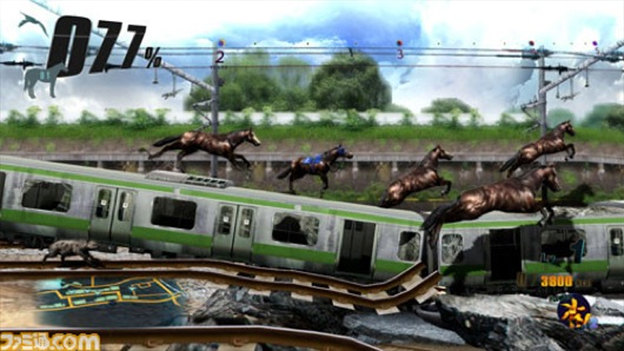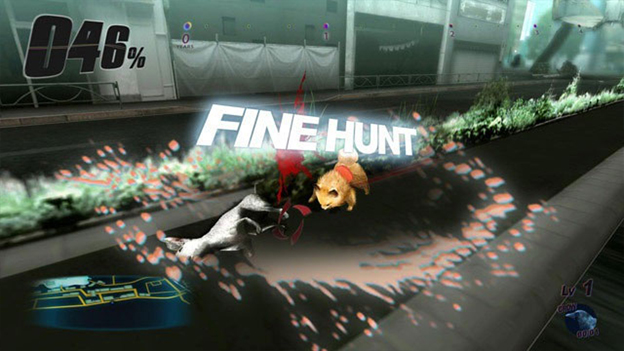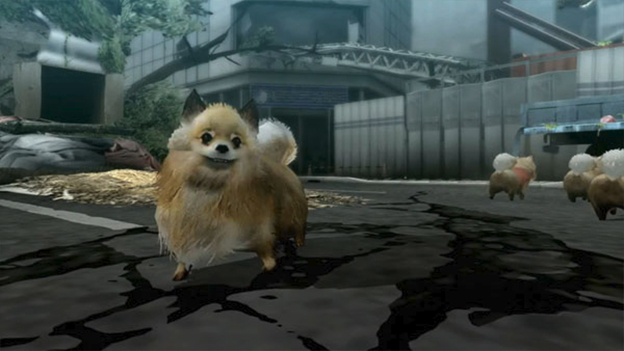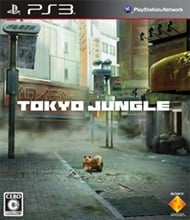Where The Wild Things Are
Typically, when a game developed by Sony’s exclusive Japan Studio comes Stateside, we expect it to be a little bit off the beaten path. Tokyo Jungle does so without going completely out in left field, and has many charms that are well worth the modest price. It does suffer from a technical standpoint, but the action is undeniably addictive, and there’s plenty of replayability that will keep you going feral for Tokyo Jungle.
The story opens with a very brief montage of a Tokyo bereft of people and being reclaimed by encroaching florae. Humans have mysteriously vanished. After ten years of this, the animals (who were apparently spared this apocalypse) are fighting for control of the urban jungle. Pets have receded from domestication, zoo creatures have sprung loose, and even a few prehistoric creatures have made a return. It’s an odd introduction that leaves you with some big questions, but no humans to answer them.

So you simply accept the premise and move into the tutorial, starting as a cute and cuddly Pomeranian dog. Learning the basics though, you quickly find a commonality with other post-apocalyptic scenarios—it’s a dog eat dog world, literally. Being shown the ropes, you learn how to move stealthily between patches of tall grass to avoid detection from animals higher up on the food chain. From there you can perform sneak attacks for critical hits or even “Clean Kills” on weaker creatures. Swiping and dodging against similarly skilled animals round out the simple combat. Though there are many different species to unlock throughout the game, they are all categorized into two classes: predators and grazers. Predators—like dogs, hyenas, and lions—strip the bones off of killed creatures for sustenance, while grazers must forage for edible plant life to survive.
Everything seems a simple process in design, but you’ll quickly discover that strategy is key to survival, and several factors increase the sense of urgency. The most important bar in the HUD is the hunger meter. It gradually decreases until you find food or water to replenish it. However, plants and animals do not respawn, so if you wipe a zone clean by feeding on every source you pass, your hunger gauge will dwindle. Once in a famished state, your health is the bar that begins depleting, until you feed again or die. Other random events, such as smog and acid rain, will increase the toxicity, and after breaching the hundred-point threshold, the contamination will decrease your health.
You must also watch the years as they pass (which is relatively quick in Tokyo Jungle). Animals don’t live much beyond fifteen years, and if you have not found a mate and procreated, old age will claim you and end the game. Reproducing is no easy feat either. First you must mark your territory. The map is sectioned off into zones, and each zone has specifically located points that must be marked. Once all the locations have been checked, you have secured the territory and a mate will enter the perimeter. Your potential spouse could be fickle, however, and you may need to raise your standing by hunting and feeding before they will oblige to coitus. After finding the nesting spot and doing the deed, a group of offspring are born, and a new generation begins.

Turning over a new generation has many benefits. The offspring will inherit some statistical bonuses the parents acquired before copulating. Also, though you only control one animal of the new troupe, the others can attack creatures if you are playing a predator, or cause a diversion if playing a grazer. Also, should you die, you will take the spot of a remaining family member, which basically acts as an extra life. Finally, the stat improvements through changing generations are saved, so you will begin new games with superior animals.
You earn Survival Points for hunting, ranking up, taking territories, changing generations, and simply for surviving. Also, each species has challenges that award you points. These challenges act as a guide throughout the journey, such as killing a certain number of animals, claiming specific territories, and reaching new generations. There’s even a special challenge that will unlock a new animal for purchase in the creation screen. You can then use your pooled Survival Points to permanently access these new beasts, and spend a little more for extra customizations. The only issue I had with the challenge system is that sometimes the next one on the list would not complete retroactively. Therefore if I marked all locations in a zone before the appropriate challenge was activated, I needed to move to a new (and more difficult) area to capture new territory spots. It forces you to plan ahead, which is fine, but when some challenges clear retroactively and others do not, it just seems like a technical error in the development.

Besides killing, feeding, and procreating, you’ll also stumble upon clothing and accessories wrapped up in pretty little bowed boxes. Donning them may feel a bit like playing Nintendogs, but the duds in Tokyo Jungle increase your stats, making them silly looking but useful upgrades. If you keep a sharp eye on the map, you’ll also notice archives scattered about. These collectibles reveal e-mail, letters, and other communications left behind by humans. Collecting them all may even reveal the cause of mankind’s disappearance.
Technically, the game is very outdated. The graphics are comparable to those found on previous generation consoles, and even there wouldn’t score well. The animal models are done well enough to distinguish each species, but the animations are stiff and the texture effects practically non-existent. The overgrown urban backdrop is rigid and lacking in color but, considering the story, is passable.

The music and sound effects also get a subpar rating. During gameplay there’s a redundant light punk rock orchestration, which varies little throughout each zone. It’s not overbearing, but it’s certainly underwhelming. I would have actually preferred no music at all, just the sound of the wind and animal noises. However, the animal effects aren’t any better. The various barks, howls, roars, and other animal utterances seem like they were pulled from a generic sound bite folder rather than being painstakingly acquired by the studio’s audio department.
As indicated in the rating description below, the overall score is not an average. I can’t give much for the graphics and sound, yet once you start playing Tokyo Jungle you likely won’t care about the technical shortcomings. It’s a quirky take on the post-apocalyptic survival genre, where beasts are the controlled characters and humans are nowhere to be seen. The premise of scavenging for food, marking territories, and creating offspring may sound like an odd gameplay mix, but for reasons you may not understand, you’ll likely return for another round, and another, and continue so on without getting bored. There are dozens of animals to try out and level up, a deeper than expected strategy to maximize your end score, and a ton of replay value for only fifteen bucks.
RATING OUT OF 5 RATING DESCRIPTION 2.6 Graphics
You’ll swear this was developed for the PS2, or even PSX! Everything runs fine though, and it’s pretty glitch-free. 3.5 Control
The animations may be stiff, but the controls are tight. Stalking prey and lunging for the kill are infinitely satisfying. 2.6 Music / Sound FX / Voice Acting
None of it is memorable, and with no humans, there’s obviously no voice acting. But at least the various creature sounds are authentic. 4.7 Play Value
It’s a bargain price for a lot of replay value. Animals to unlock and improve, archives to collect, and the ever-present addiction to beat your own score. 4.0 Overall Rating – Great
Not an average. See Rating legend below for a final score breakdown.
| Review Rating Legend | |||
|---|---|---|---|
| 0.1 – 1.9 = Avoid | 2.5 – 2.9 = Average | 3.5 – 3.9 = Good | 4.5 – 4.9 = Must Buy |
| 2.0 – 2.4 = Poor | 3.0 – 3.4 = Fair | 4.0 – 4.4 = Great | 5.0 = The Best |
Game Features:
